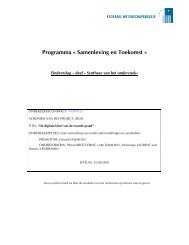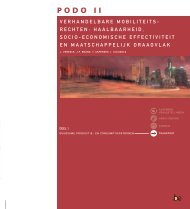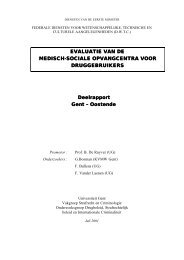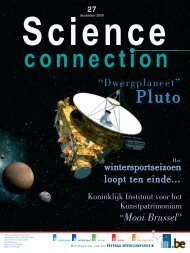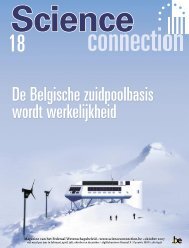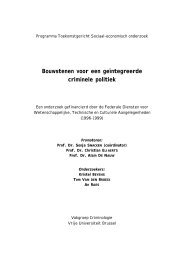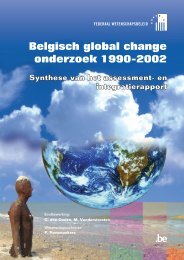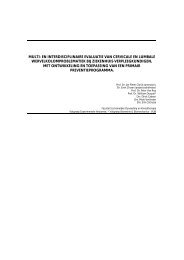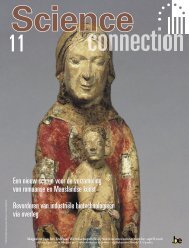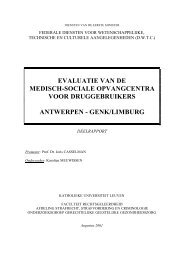chapter 3 inventory of local food systems
chapter 3 inventory of local food systems
chapter 3 inventory of local food systems
You also want an ePaper? Increase the reach of your titles
YUMPU automatically turns print PDFs into web optimized ePapers that Google loves.
Project CP/59 - “Instruments and institutions to develop <strong>local</strong> <strong>food</strong> <strong>systems</strong>”<br />
This procedure is repeated several times before coming to a moment <strong>of</strong> synthesis. For<br />
this, the participants take note <strong>of</strong> the conversations at the various tables and a final<br />
dialogue is held in plenary. After the café, the organisers process all results in a written<br />
document to be sent to all participants.<br />
After two presentations with the main results and recommendations <strong>of</strong> the research<br />
projects, three rounds <strong>of</strong> dialogue were held with as central question: “How can<br />
sustainable <strong>food</strong> chains be strenghtened?”. In the second round, a new question was<br />
introduced to focus on what is new (‘What new things did you learn?’), while in the final<br />
round participants were asked to specifically search for elements needed for change<br />
(‘What is needed to bring about change?’). In plenary conversation, every table was<br />
asked to think about what they think is the most important lever to strengthen<br />
sustainable <strong>food</strong> chains.<br />
5.2.3. Levers to strengthen sustainable <strong>food</strong> chains<br />
After the workshop, we clustered the reactions, ideas and what was written on the table<br />
cloths into the following four levers:<br />
1. Consciousness <strong>of</strong> the consumer through responsibilisation. In this special<br />
attention is devoted to the clarity <strong>of</strong> the principles <strong>of</strong> sustainability and their<br />
dissemination in an innovative and creative way (particularly to access young<br />
people). Through consciousness, participants felt the need to work on the<br />
responsibility <strong>of</strong> the consumer, with his increased participation in sustainable<br />
<strong>food</strong> chains as a possible result. However, some draw attention to the choice<br />
and the voice <strong>of</strong> the consumer, who is not always willing or able to spend<br />
more money on buying <strong>food</strong>.<br />
2. More sales by more creative marketing. Innovation should respond to social<br />
reality. One aspect that disserves more attention is the possible symbiosis<br />
between sustainability and scale economies, that is, to couple efficient<br />
distribution in mainstream supply chains with communication, fair prices and<br />
long-term relationships that characterise LFS. Both <strong>local</strong> and mainstream <strong>food</strong><br />
<strong>systems</strong> may benefit from existing product image assets, such as price and<br />
quality as well as assets that yet need to be further developed, such as<br />
products’ connectedness to the region and organic character.<br />
3. Building competences by pr<strong>of</strong>essionalisation and guidance. Guidance and<br />
support should be more oriented towards the development <strong>of</strong> skills and the<br />
further pr<strong>of</strong>essionalisation <strong>of</strong> sustainable <strong>food</strong> chains. In that sense, the central<br />
question was reformulated as follows: ‘How can sustainable <strong>food</strong> chains<br />
strengthem themselves?’ Government should work out policies that are<br />
supportive and motivating and that creates (financial and legal) space for<br />
innovation. Support and guidance <strong>of</strong> supply chains should be more coherent<br />
by bundling the efforts <strong>of</strong> different institutions into a network.<br />
4. Stimulating and facilitating government framwork. Government has an<br />
important stimulating and facilitating role in each <strong>of</strong> the aforementioned<br />
SPSD II - Part I - Sustainable production and consumption patterns - Agro-Food 72



